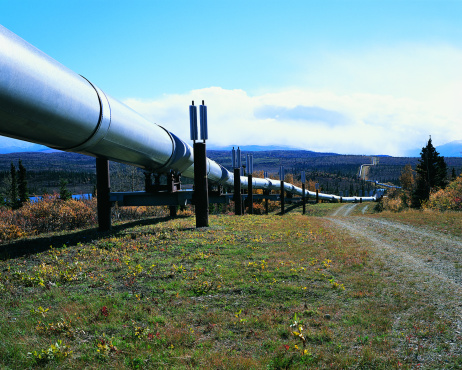Ever since finding out about the midstream/pipeline space, I have been drawn to the sector. There are many advantages that companies in this space tend to offer. Although they do have, typically speaking, a lot of debt on their books, they generate tremendous amounts of cash. They steadily grow and are financially predictable. They also pay out a lot of that cash, while also trading at rather cheap multiples. While not my favorite in the space, one player that is certainly worthy of attention is Enterprise Products Partners (NYSE:EPD).
For those not familiar, Enterprise Products Partners is a behemoth in the energy transportation and storage market. The firm has over 50,000 miles of pipeline and is responsible for transporting NGLs, crude oil, natural gas, petrochemicals, and a wide array of refined products. It has over 300 million barrels worth of liquids storage capacity, 20 deep water docks, 42 natural gas processing drains, 26 fractionators, and countless additional assets. While the company focuses largely on areas around the Gulf of Mexico, with most of its assets split between Texas and Louisiana, it does have a network that spans several other states, including up into New York.
The last article that I wrote about the firm was published in February of this year. In that article, I warned investors to not ‘let this cash cow slip by’. The firm boasted a 7.73% yield and was trading at attractive levels. This led me to reiterate the ‘buy’ rating that I had on the stock at the time. And since then, things have gone quite well. Shares have generated upside for investors of 11.1%. That dwarfs the 3.9% increase seen by the S&P 500 over the same window of time. You would think that, given this upside, shares might finally be at fair value. But I would argue that additional upside is still on the table.
Still a solid opportunity
Since I last wrote about Enterprise Products Partners earlier this year, we have had only a little extra data come out about the company. This data covers the first quarter of the 2024 fiscal year. Although not entirely irrelevant, I have long maintained that revenue and net income is not terribly significant for these types of firms. Rather, it’s cash flow that matters. But for the sake of being comprehensive, it wouldn’t hurt to touch on both of these metrics briefly.
Author – SEC EDGAR Data
During the first quarter of 2024, revenue for the company came in at $14.76 billion. This represents an increase of 18.6% over the $12.44 billion generated one year earlier. Three of the company’s four segments contributed to this upside. The one exception was the Natural Gas Pipelines & Services segment, with revenue dropping from $1.22 billion to only $854 million. Most of this decline was driven by a drop in the sale of natural gas. This was in spite of the fact that the volume of natural gas transported actually rose from 18,023 Bbtus per day to 18,615 BBtus per day thanks to a larger network and higher demand for natural gas. However, lower average sales prices for the commodity pushed revenue down by $343 million.
Enterprise Products Partners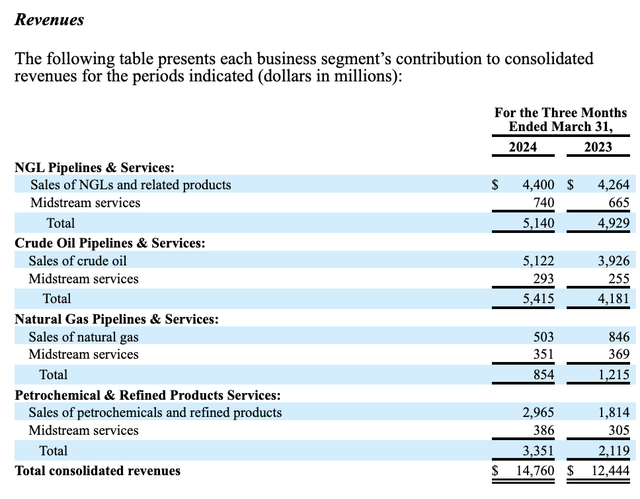
As you can see in the image above, the other three operating segments of the business reported rather substantial increases in revenue on a year-over-year basis. This can really be attributed to higher sales volumes that more than offset a slight decline in average sales prices. Collectively, revenue for midstream services also grew. The increase in sales brought with it a rise in the firm’s gross operating margin from $2.34 billion to $2.49 billion. Most of that improvement came from the firm’s NGL Pipelines & Services segment, with a rise from $1.21 billion to $1.34 billion. This is largely attributable to higher average sales margins, higher average processing margins, an increase in fee-based natural gas processing volumes, rising export volumes, rising transportation fees associated with certain pipelines like its Eastern ethane pipelines, additional storage revenue, and rising fractionation volumes that brought with them higher ancillary service sales.
Enterprise Products Partners Enterprise Products Partners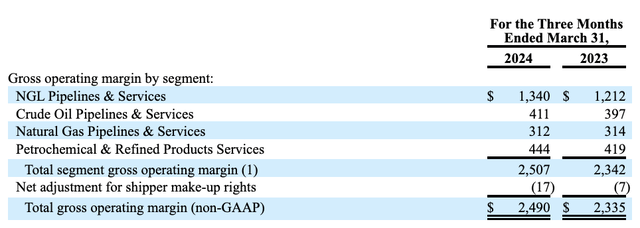
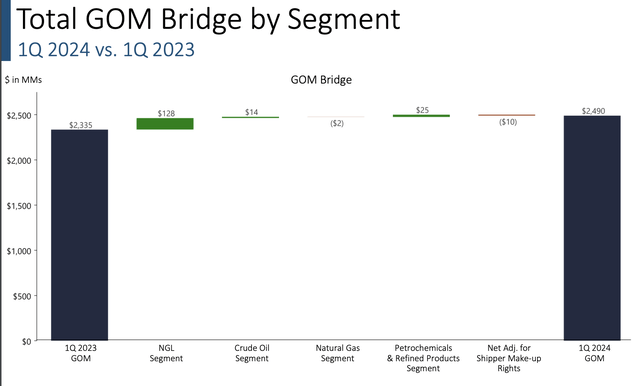
These increases allowed net profits to grow from $1.39 billion to $1.46 billion. But even more important than this, other profitability metrics grew as well. Operating cash flow, for instance, expanded from $1.58 billion to $2.11 billion. If we adjust for changes in working capital, we get a more modest increase from $2.02 billion to $2.15 billion. When I look at this space, I also like to look at what I call ‘true free cash flow’. This essentially takes adjusted operating cash flow and strips out from it maintenance capital expenditures. This avoids punishing the company from a valuation perspective for growth-oriented initiatives. True free cash flow managed to rise from $1.94 billion in the first quarter of 2023 to $1.97 billion the same time this year. DCF, or distributable cash flow, grew from $1.92 billion to $1.94 billion. And lastly, EBITDA for the company expanded from $2.32 billion to $2.47 billion.
Author – SEC EDGAR Data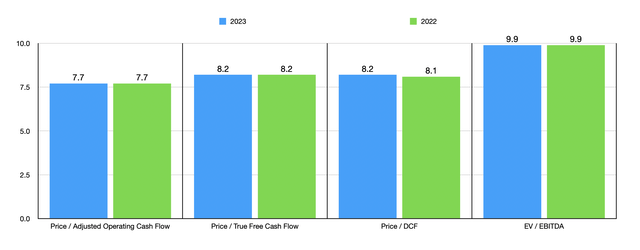
Valuing a company like Enterprise Products Partners, it’s not that difficult. Taking a few of these metrics, I then created the chart above. In it, you can see that, from 2022 to 2023, pricing for the firm remained almost identical. I then compared the firm to five similar companies as shown in the table below. I did this using two of the four metrics. The first one, the price to adjusted operating cash flow multiple, revealed that three of the five companies were cheaper than Enterprise Products Partners. But when we use the EV to EBITDA approach, this number drops to only one of the five.
| Company | Price / Operating Cash Flow | EV / EBITDA |
| Enterprise Products Partners | 7.7 | 9.9 |
| TC Energy (TRP) | 7.4 | 13.5 |
| Kinder Morgan (KMI) | 6.7 | 11.6 |
| The Williams Companies (WMB) | 8.6 | 10.4 |
| Enbridge (ENB) | 7.9 | 12.8 |
| Energy Transfer (ET) | 5.2 | 8.7 |
Part of this disparity in pricing can be chalked up to the low leverage that Enterprise Products Partners has. As you can see in the chart below, our candidate has a net leverage ratio of 3.12. This is actually the lowest of the six companies we are looking at throughout this article. The next closest is my own personal favorite, Energy Transfer, which has a net leverage ratio of 3.40. All of the other players have readings of between 4.38 and 6.22. I would argue that such a disparity probably does warrant a premium for companies like Enterprise Products Partners and Energy Transfer because it means that risk is reduced.
Author – SEC EDGAR Data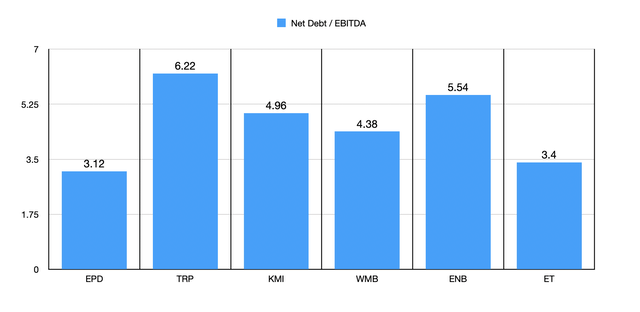
There are a couple of other important metrics that we can use to gauge the quality of these businesses. The two that I have in mind can be seen in the chart below. The first involves the yield, which is how much investors get as a distribution each year by buying the stocks of said firms at current prices. This assumes no change in distribution policy. Three of the five companies have a yield that is lower than Enterprise Products Partners’ 7.15%, with the other two having yields that are higher.
Author – SEC EDGAR Data
The other metric is the payout ratio, which looks at how much of adjusted operating cash flow is being paid out for common distributions. At 52.94%, Enterprise Products Partners is near the higher end of the spectrum, with only one of the five companies I compared it to higher than it. This means that the other firms could boost their payouts if they so desired. However, as shown in the subsequent chart, even if the firms could all pay out the same percent of their cash flows without seeing a change in their share prices in response to this development, only two of the five companies would succeed in having higher yields than what Enterprise Products Partners has. These would be TC Energy at 9.72% and Energy Transfer at 10.85%.
Author – SEC EDGAR Data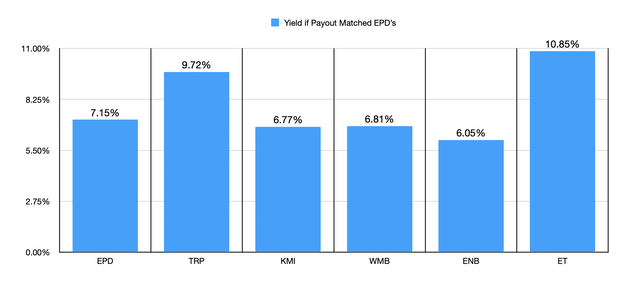
Outside of valuation and corporate health, it’s also helpful to look at the long-term picture. At present, the management team at Enterprise Products Partners has made clear that it has $6.9 billion worth of approved major projects that are currently under construction. Up to $3.75 billion could be spent on those growth initiatives this year alone. Up to another $3.75 billion is planned for next year, followed by as much as $2.5 billion in 2026. In the long run, these initiatives should help the company to grow even further. That can only be a good thing, so long as leverage does not change much from where it is now. The good news is that, with the cash flows the company is generating, this should not be a problem.
Enterprise Products Partners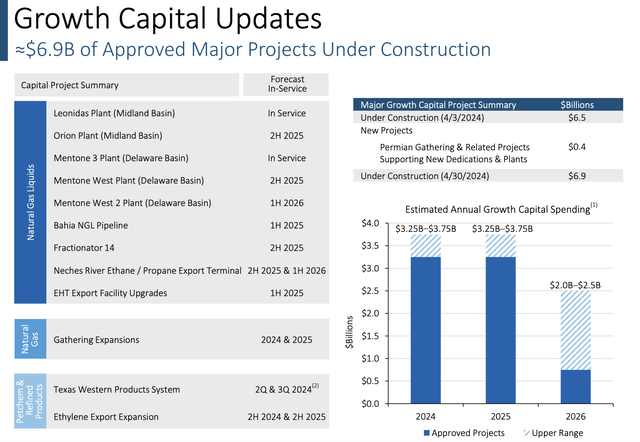
Takeaway
The way I see it, Enterprise Products Partners is a really solid company with a great future. For somebody who wants a high yielding cash cow that offers long-term stability, this is definitely an opportunity to keep in mind. It’s not the cheapest player in the space, nor should it probably be the cheapest. Leverage is low, and growth initiatives look set to boost profitability in the long run. But for those who just want a quality company that should do well, a ‘buy’ rating should make a lot of sense.
Read the full article here
